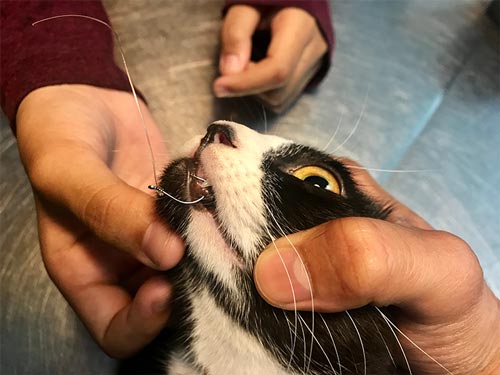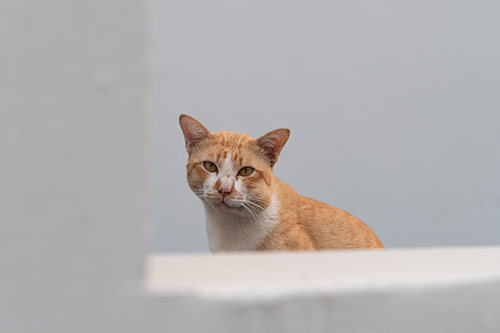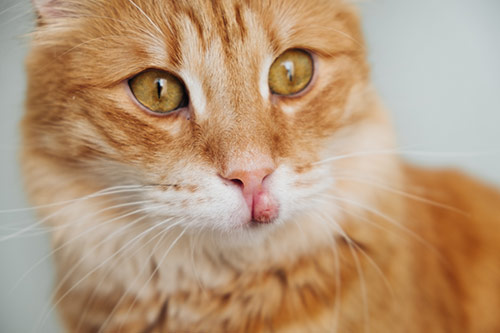You may or may not have noticed much about your cat’s lips, that is until they showed up with a bump or sore on them. Just like other parts of the skin, a cat’s lips are subject to a number of crazy and painful things, including sores, ulcers and bumps. We’re here to help you determine what may be the cause of those lip bumps and sores and what should be done about them.
What are lip bumps and sores in cats?
The lips of a cat (and humans for that matter) are made up of a special type of skin. They form the junction between the tough, haired skin of the face and the softer mucous membrane skin of the mouth. The skin of the lips doesn’t contain sweat or oil glands or hair, and is significantly thinner than skin on the rest of the body. All of these differences add up to lip skin being more sensitive to not only injury, but diseases and other ailments as well.
Causes of lip bumps and sores in cats (with pictures)
A bump often looks like a bump and a sore often looks like a sore despite having different causes. That’s why it usually takes a combination of looks and other signs to determine the cause of lip bumps, sores, and ulcers in cats. With that in mind, here are some possible causes and what you and a vet can do about them.
1. Injury
Cats are curious creatures and all too commonly get themselves into sticky situations. Sometimes those situations can land then with a sore or bump on their lips. Injuries to the lips may also come with other swellings or cuts on other parts of the face or paws. Kitties may drool or paw at their mouth or gag. There may be lots of blood or just swelling. The severity of the injury can depend on what caused it. Just a quite note here: injuries can be due to fighting or biting something they shouldn’t as well as licking chemicals from their fur, so be sure to store home and yard chemicals in a safe area and don’t use then when your cat is immediately around.
You may start by trying to clean the face, mouth and lips with warm water and flush any sores with saline solution. From there, see a vet if the injuries are extensive or if your cat doesn’t want to eat or is also having trouble breathing.
The vet will also examine and clean the injury, which may require sedation. Stitches may be needed or even surgery if injuries include broken bones. Antibiotics and bandaging may be necessary.

2. Infection
Bacteria and viruses love a cat’s lips. Many infections can cause sores not only the lips of a cat but also in their mouth. Along with lip and mouth ulcers, you may also see runny eyes and nose, sneezing, coughing, and lethargy. Cats may have a reduced appetite and weight loss as well.
Some viral infections in cats can be treated with supportive care and others can’t be cured. If your kitty has a mild infection, you can try gently cleaning their lips with warm water and a mild soap. Offer then softer food to up their appetite and give them a little rest and relaxation. Keep other kitties away as most infections are eager to spread. View this picture on KingsRidge Vet.
For more severe infections or painful lip sores, see your veterinarian. This means if your cat isn’t eating, is running a fever, or is lethargic. They can treat with supportive care, such as fluids, and antibiotics. In some cases, your vet may prescribe a lysine supplement (Amazon link), such as Vetoquinol, to help manage certain viral infections.
3. Dental disease
The teeth are in close proximity to a cat’s lips so it would make sense that something affecting the teeth and gums could affect the lips as well. When cats get a buildup of plaque and tartar on their teeth it can lead to gingivitis and tooth abscesses. These can show up as swellings in the lips and jaw and redness and sores on the lips. Dental disease can also cause bad breath, drooling, bleeding from the mouth, decreased appetite, weight loss, and of course pain.

Dental disease can be prevented at home but is best treated by a veterinarian. Prevention includes regular tooth brushing or the use of anti-plaque sprays or gels. Treatment includes antibiotics and a professional cleaning. Severe dental disease may also need some tooth extractions.
4. Rodent ulcers
Rodent ulcers, otherwise known by their long-form name of eosinophilic granuloma complex, is a scary-looking form of ulcer on the lips of cats. These ulcers form partially due to an allergic reaction and partially due to genetics. They can be very mild, creating only a small, often unnoticed ulcer on the upper lip, or they can be severe, causing large ulcers that even disfigure the upper lip. Similar ulcers, or plaques, may appear on the stomach and hind legs at the same time.
Cats will often lick the ulcer frequently as they can be itchy, which can make the ulcer worse in a vicious cycle. Don’t try treating this one at home, instead you’ll want the help of your vet to do some investigating. Treatment may include a hypoallergenic diet, steroids, or immune suppressants.
View this picture on Medium.
5. Allergies
Not every allergic reaction is going to lead to something like rodent ulcers. Instead, allergies to plants, cleaning chemicals and even insect bites can lead to small swellings and red bumps on a cat’s lips and other areas of their face and body. They may be itchy and have watery eyes and a runny nose as well. Bee stings and insect bites can cause an allergic reaction that swells very quickly and can even be life-threatening if it affects a cat’s airways.
If you’re able to determine what your cat is allergic to, by all means, treat them at home by getting rid of the allergen. However, most cases of lip sores and bumps due to allergies are going to take a veterinarian’s care. Allergy testing may be enlisted and a change in diet, antihistamines and anti-inflammatories may be instore.
Let’s also include foreign objects in this section, since these can elicit a reaction complete with swelling, redness, and heat similar to an allergic reaction. Things like thistle stickers and grass seeds can become embedded in a cat’s lips and lead to a bump or sore. Antibiotics may be necessary or even surgical removal.

6. Tumors
Squamous cell carcinoma and melanoma are a couple common tumors that can show up in a cat’s mouth and lips. These bumps can show up suddenly and grow quickly. They may bleed and make it difficult for a cat to eat. Lips tumors may be different colored than the surrounding skin and oddly shaped. If you notice a bump like this on your cat’s lips or in their mouth, don’t wait, call your vet. The sooner you find out what the bump is, the sooner you can start treatment.
If immediate vet attention isn’t an option, consider taking a picture so that you can monitor size, shape, and color. Anything that grows and changes quickly should be considered suspicious. Tumors on the lips will need to be diagnosed through a biopsy or by taking a sample with a needle. They can then be treated using antibiotics, steroids, or surgical removal.

7. Kidney failure
Cats with later stages of kidney failure may show up with sores on their lips and mouth. This is because the kidneys are responsible for filtering the blood. When they’re not working well, as with kidney disease, toxins that would normally be filtered out build up on the blood. These toxins can damage the sensitive skin of the lips and mouth also creating bad breath, difficulty eating and bleeding.
Kidney disease can’t be cured but it can be managed. Unfortunately, by the time sores on the lips start showing up, most kitties are beyond the stages where it can be managed effectively. Supportive care with fluids, a change in diet, and phosphorus binders may be helpful.
Picture: view this picture on ResearchGate (8a and 8b)
When to visit the vet for lip bumps, sores, and ulcers in cats
There are cases of mild lip bumps or sores where you may choose to monitor your cat rather than rush them to the vet. However, most lip sores can be quite painful, and the longer you wait before treating, the more likely it is your cat will have trouble eating.
So, if notice a small bump or sore on your cat’s lips and they are otherwise feeling fine, you may decide to give them a day or two before you pick up the phone. However, if they seem painful, aren’t eating, there are any other signs like runny nose and watery eyes, or other injuries and bleeding, see your vet. If the bump grows quickly, changes shape or color, or if they have a swelling that is impeding their breathing, get attention quickly.
Veterinary diagnosis and costs
The first thing your vet is going to do is get a good look at your cat’s lips and mouth. This may involve sedating them for the best view. They will also want to know when the issues showed up, if they’ve gotten worse or improved and if you’ve done anything for them at home. From there your vet may take samples of the sores or bumps, run blood work, or do imaging to check for other injuries.
Treatment is going to depend on the cause and may be as simple as antibiotics or as complex as surgery to repair broken bones or remove tumors. This means that the cost to diagnose and treat lip bumps and sores will also vary. An exam and medication may cost $50-$100, while a biopsy may add an additional $100. A professional dental may cost $200-$800 and surgery may run $500-$1,000.
FAQs
Can lip bumps, sores, or ulcers by a sign of a serious health issue?
Lip bumps, sores and ulcers may indicate that your cat has serious kidney failure or cancer. They may also indicate a lifelong viral infection that will need lifelong management.
How are lip bumps, sores, and ulcers diagnosed in cats?
Veterinarians can diagnose the cause of lip bumps, sores, and ulcers through an examination and history and possibly a sample collection. The exam will show them the extend of the problem, the history may help them rule out causes, and the sample collection will help them see what is making up the lesion. They may take a scraping, fine-needle aspirate or biopsy of the problem.
Are there any home remedies or treatments I can try before seeing a vet?
As long as the bump or sore on your cat’s lip is small and they don’t seem to be in pain or not eating, you may try washing the area with warm water and a mild soap. Flush sores with saline solution to remove any irritants and to keep them clean. If you know your cat has a persistent viral infection, supplementing with lysine may help.
How can I prevent lip bumps, sores, and ulcers in my cat?
The best way to prevent lip bumps, sores, and ulcers is to find out the underlying cause. If your cat has allergies, try to remove the allergen or give them antihistamines. If they have a viral infection, separate them from other cats and try lysine. Get regular veterinary checkups to watch out for dental disease and keep an eye on kidney function.

